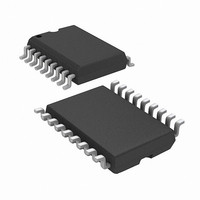RFHCS362GT-I/SO Microchip Technology, RFHCS362GT-I/SO Datasheet - Page 4

RFHCS362GT-I/SO
Manufacturer Part Number
RFHCS362GT-I/SO
Description
IC CODE HOPPNG ENCDR W/RF 18SOIC
Manufacturer
Microchip Technology
Datasheet
1.RFHCS362F-ISS.pdf
(60 pages)
Specifications of RFHCS362GT-I/SO
Frequency
310MHz ~ 440MHz
Applications
Automotive, Building Access, Garage Openers
Modulation Or Protocol
ASK, FSK
Data Rate - Maximum
3.3 kbps
Power - Output
-12dBm ~ 2dBm
Current - Transmitting
11.5mA
Data Interface
PCB, Surface Mount
Antenna Connector
PCB, Surface Mount
Voltage - Supply
2.2 V ~ 5.5 V
Operating Temperature
-40°C ~ 85°C
Package / Case
18-SOIC (0.300", 7.50mm Width)
Lead Free Status / RoHS Status
Lead free / RoHS Compliant
Features
-
Memory Size
-
rfHCS362G/362F
• Manufacturer’s code – A unique and secret 64-
1.2
The rfHCS362G/362F is suited for secure wireless
remote control applications. The EEPROM technology
makes customizing application programs (transmitter
codes, appliance settings, etc.) extremely fast and con-
venient. The small footprint packages are suitable for
applications with space limitations. Low-cost, low-
power, high performance, ease of use and I/O flexibility
make the rfHCS362G/362F very versatile. Typical
application circuits are shown in Figure 1-5 and
Figure 1-6.
Most low-end keyless entry transmitters are given a
fixed identification code that is transmitted every time a
button is pushed. The number of unique identification
codes in a low-end system is usually a relatively small
number. These shortcomings provide an opportunity
for a sophisticated thief to create a device that ‘grabs’
a transmission and retransmits it later, or a device that
quickly ‘scans’ all possible identification codes until the
correct one is found.
The rfHCS362G/362F, on the other hand, employs the
K
mission length of 66 bits to virtually eliminate the use of
code ‘grabbing’ or code ‘scanning’. The high security
level of the rfHCS362G/362F is based on patented
32 bits and a key length of 64 bits is used. The algo-
rithm obscures the information in such a way that even
if the transmission information (before coding) differs
by only one bit from that of the previous transmission,
the next coded transmission will be completely differ-
ent. Statistically, if only one bit in the 32-bit string of
information changes, approximately 50 percent of the
coded transmission bits will change.
DS41189A-page 4
technology. A block cipher based on a block length of
EE
- Normal Learning
- Secure Learn
bit number used to generate unique encoder
encryption keys. Each encoder is programmed
with a encryption key that is a function of the man-
ufacturer’s code. Each decoder is programmed
with the manufacturer code itself.
L
The receiver uses information transmitted
during normal operation to derive the encryp-
tion key and decrypt the received code
word’s encrypted portion.
The transmitter is activated through a special
button combination to transmit a stored 60-bit
seed value used to generate the transmitter’s
encryption key. The receiver uses this seed
value to derive the same encryption key and
decrypt the received code word’s encrypted
portion.
OQ
code hopping technology coupled with a trans-
Applications
Preliminary
FIGURE 1-1: ADDITIONAL BUTTON INPUTS
Up to 7 button inputs can be implemented making them
look like a binary value to the 3 Sx inputs. This is done
with switching diodes as shown in Figure 1-1. The dis-
advantage is that simultaneously pressed buttons now
appear as if a single button is pressed.
The rfHCS362G/362F has a small EEPROM array
which must be loaded with several parameters before
use. These are most often programmed by the manu-
facturer at the time of production. The most important
of these are:
• A 28-bit serial number, typically unique for every
• An encryption key
• An initial 16-bit synchronization value
• A 16-bit configuration value
The encryption key generation typically inputs the
transmitter serial number and 64-bit manufacturer’s
code into the key generation algorithm (Figure 1-2).
The manufacturer’s code is chosen by the system
manufacturer and must be carefully controlled as it is a
pivotal part of the overall system security.
The 16-bit synchronization counter is the basis behind
the transmitted code word changing for each transmis-
sion; it increments each time a button is pressed. Due
to the code hopping algorithm’s complexity, each incre-
ment of the synchronization value results in about 50%
of the bits changing in the transmitted code word.
encoder
B4 B3 B2 B1 B0
2002 Microchip Technology Inc.
S0
S1
S2
RFEN
V
DD












